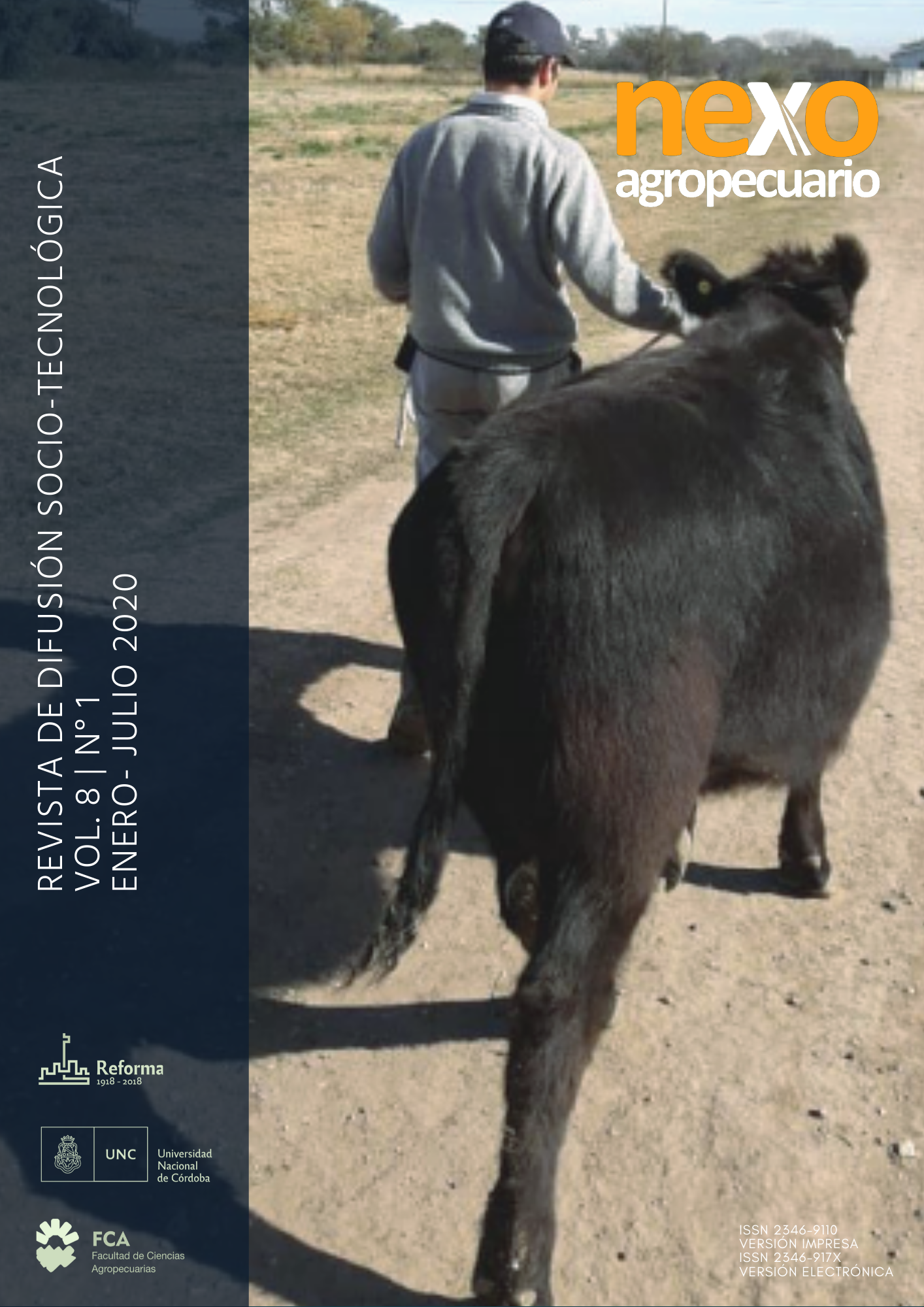Evaluation of sesame performance (Sesamum indicum L.) variety ¨White Broom¨ under different planting dates and densities.
Keywords:
Keywords: Sesamum indicum L., date and density of planting, semi-arid central region of Cordoba.Abstract
The objective of this work was to analyze the effect of the date and density of planting on agronomic behavior in a sesame crop conducted in dry land in the central region of the province of Córdoba. The trial was carried out during the 2018-2019 agricultural campaign in the Experimental Area of the Field School of the Faculty of Agricultural Sciences (UNC). The Sesame White Broom variety was grown on the following four planting dates: September 29, October 27, November 30, and December 30, 2018. On each date, two planting densities were used, 8 m-2 plants and 12 m-2 plants. From the harvest of the central groove of each plot, the following variables were measured or estimated: grain yield (kg m-2), weight of 1000 grains (g) and number of grains per m2. Hail occurred on February 11, 2019 impacted on the duration of the different phenological stages in sesame cultivation. If we look at the extreme planting dates (September 27 and November 30) it was observed that the growing cycle was shortened by 25 days. Having excepted for the damage by hail, it can be said that with the first two planting dates (end of September and the end of October) yields above the ton of grain per hectare were achieved. Beyond the hail damage suffered by the sesame crop on the occasion of being evaluated on three dates and with two stocking densities, it can be said that the yields achieved in the semi-arid central region of the province of Córdoba do not detract from those achieved in other regions of the world and that densities above 12 plants per square meter should be explored.
References
Abdalla, A. A. (2003). Effect of sowing date and plant population on performanceof sesame (Sesamumindicum L) cultivars under irrigation (Doctoral dissertation, M. Sc. Thesis, Faculty of Agricultural., University of Khartoum).
Acuña, M. A. V. H., & de Cristaldo, R. M. O. (2014). Población de plantas y su efecto en el desarrollo vegetativo y rendimiento del sésamo (Sesamumindicum L.) variedad Escoba. Investigación Agraria, 14(1), 25-30.
Adebisi, M. A., Ajala, M. O., Ojo, D. K., &Salau, A. W. (2006). Influence of population density and season on seed yield and its components in Nigerian sesame genotypes. Journal of tropical agriculture, 43, 13-18.
Andrade, F. H., Cirilo, A. G., Uhart, S. A., & Otegui, M. E. (1996). Ecofisiología del cultivo de maíz (No. 633.15 584.92041). Dekalb Press.
Arriel, N. H. C. (1997). Diagnóstico e perspectiva do gergelim no Brasil. Reunião temática matérias-primas oleaginosas no Brasil: diagnóstico, perspectivas e prioridades de pesquisa. Campina Grande. Anais. Campina Grande: EmbrapaAlgodão/MAA/ABIOVE, 119-138.
Asthana, K. S., & Narain, B. (1977). Evaluation of sesame varieties in Bihar for summer. Indian journal of agricultural sciences.
Calonga, F. J. (2002). Caracterización agronómica de cuatro variedades de sésamo (Sesamumindicum L.), sembradas en cuatro épocas diferentes en el Distrito de Minga Guazú (Doctoral dissertation, Tesis Ing. Agr. Minga Guazú, PY: CIA, UNE).
Cámara Paraguaya de Exportadores del Sésamo (Capexse). (31 de Marzo de 2018). www.ultimahora.com. Obtenido de www.ultimahora.com: https://www.ultimahora.com/aumentaron-area-y-rindes-del-sesamo-n1140497.html.
Carreño, B. L., Terrazas, D. B., Orquera, E., Zambrana, C., & Hurtado Méndez, J. (2009). El cultivo de Sésamo. Santa Cruz: CIAT (Centro de Investigación Agrícola Tropical).
Di Rienzo J.A., Casanoves F., Balzarini M.G., Gonzalez L., Tablada M. y Robledo C.W. InfoStatversión 2014. Grupo InfoStat, FCA, Universidad Nacional de Córdoba, Argentina. URL http://www.infostat.com.ar
Embrapa, (2005). www.cnpa.embrapa.br. Obtenido de www.cnpa.embrapa.br:
https://www.cnpa.embrapa.br/produtos/gergelim/index.html
Falasca, S., Anschau, A., &Galvani, G. (2010). Las potenciales áreas productivas de sésamo (Sesamusindicum l) en argentina, materia prima para biodiesel. Avances en EnergíasRenovables y Medio Ambiente, 14, 11-63.
Farina Morinigo, C. M. (2003). Epoca propicia de siembra de cuatro variedades de sésamo Sesamum indicum L.(Sesamus indicum l) en argentina, materia prima para biodiesel. Avances en Energías Renovables y Medio Ambiente, 14, 11-63.
Gabriaguez, C. L. Z., de Cristaldo, R. M. O., & Espínola, D. D. G. (2013). Rendimiento del cultivo de sésamo (Sesamum indicum L.), variedad Mbarete, en diferentes épocas de siembra y poblaciones de plantas. Investigación Agraria, 13(2), 67-74.
Khattab, A. H., & Khidir, M. O. (1970). Oil and protein content of local sesame types. Journal of food science and Technology (Sudan), 2, 8-10.
Langham, D. R. (2008). Growth and development of sesame. SesacoCorp, 329.
Lazim, M. E. H. (1973). Population and cultivar effects on growth and yield of sesame under irrigation. Lazim.
Lee, J. I., & Choi, B. H. (1986). Sesame breeding and agronomy in Korea. Crop Experiment Station, Rural Development Administration, 61.
Sanchez, M. E. J., & Acuña, R. R. D. (2013). Efecto de fósforo y nitrógeno en el rendimiento de sésamo, Sesamum indicum L., sobre un alfisol en el distrito de Horqueta. Investigación Agraria, 7(2), 42-47.
Sarkar, M. A., Salim, M., Islam, N., & Rahman, M. M. (2007). Effect of sowing date and time of harvesting on the yield and yield contributing characters of sesame (Sesamum indicum L.) seed. International Journal of Sustainable Crop Production, 2(6), 31-35.
Servicio de Información Agroalimentaria y Pesquera (SIAP). (15 de Junio de 2012). https://www.inforural.com.mx. Obtenido de https://www.inforural.com.mx: https://www.inforural.com.mx/ajonjoli-descripcion-y-variedades/
Ssekabembe, C. K. (2007). Comparison of research on sesame (Sesamumindicum) and nakati (Solanumaethiopicum) at Makerere University. In 8th African Crop Science Society Conference, El-Minia, Egypt, 27-31 October 2007 (pp. 2063-2069). African Crop Science Society.
Sistema Nacional Argentino de Vigilancia y Monitoreo de plagas. (2013).
www.sinavimo.gov.ar. Obtenido de www.sinavimo.gov.ar:
https://www.sinavimo.gov.ar/cultivo/sesamum-indicum.
Van Rheenen, H. A. (1973). Major problems of growing sesame (Sesamumindicum L.) in Nigeria (Doctoral dissertation, Veenman).
Downloads
Published
Issue
Section
License
Copyright (c) 2020 Roberto Andrés Zanvettor

This work is licensed under a Creative Commons Attribution-NonCommercial-ShareAlike 4.0 International License.
Attribution - Non-Commercial - Share Alike (by-nc-sa): No commercial use of the original work or any derivative works is permitted, distribution of which must be under a license equal to that governing the original work.


